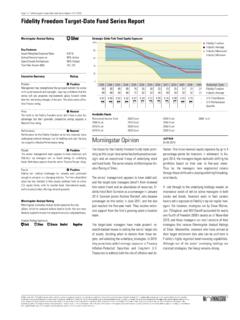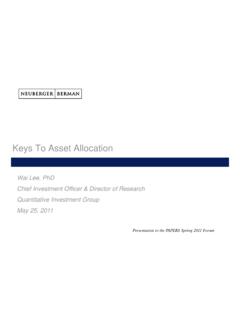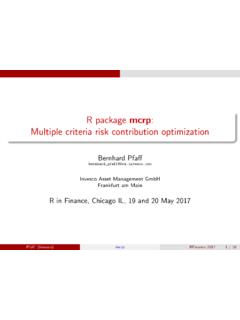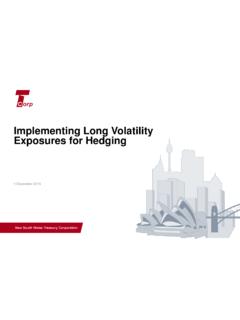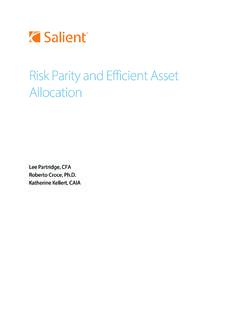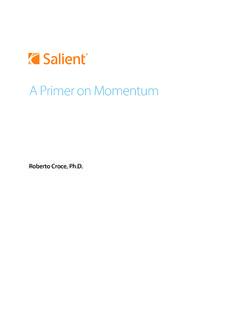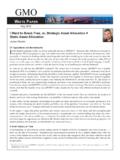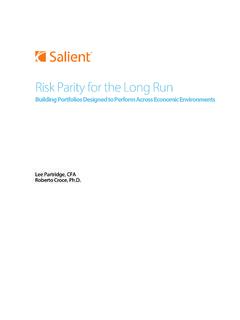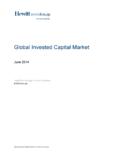Transcription of The Hidden Risks of Risk Parity Portfolios - Morningstar, Inc.
1 GMOWh i t e Pa P e rMarch 2010 The Hidden Risks of Risk Parity PortfoliosBen InkerMuch has been made in the last few years about a new variety of investment strategies broadly known as risk Parity Portfolios . These Portfolios appear to offer the beguiling combination of lower risk and higher return when compared to a traditional 60/40 stock/bond benchmark, and are more in keeping with modern financial theory. While the theory is very appealing to some, it is probably due to the fact that equities have been such a disappointing asset over the last decade that alternatives to the 60/40 portfolio like risk Parity Portfolios have come to the fore.
2 A decade ago, investors were seduced into thinking that they could have 100% (or close to 100%) equity Portfolios by looking at historical equity returns when equities had just been on their best run in history, and consequently were the most overvalued in history. By shifting to risk Parity Portfolios now, investors run the risk of loading up on fixed income duration after the best run for bonds in history, a run that has left government bonds, in our opinion, looking extremely dangerously overpriced. But apart from the tactical question of whether to move to risk Parity now, we believe more generally that the benefits that risk Parity Portfolios offer are largely an illusion, while they harbor a number of Hidden Risks that may have investors regretting their decisions a few years down the road.
3 Broadly, we believe that there are three basic weaknesses in risk Parity Portfolios . First, these Portfolios suffer from the same basic flaw as value-at-risk and other modern portfolio theory tools they confuse volatility with risk, assuming that if the standard deviation of the portfolio over some particular time period is x%, this is really all the investor needs to know. Second, some of the asset classes generally included in these Portfolios have risk premiums that we believe may well be zero or negative for the foreseeable future. And third, several of the asset classes involved in these Portfolios have significant negative skew, which makes the backtests behind them suspect and, in conjunction with leverage, may prove extremely painful to investors.
4 While there is nothing inherently wonderful about a 60/40 stock/bond portfolio , we believe that it has a couple of virtues. For one, the risk premium that dominates it the equity risk premium is the one that we think is extremely likely to be positive in the long run. And, because it does not include any leverage, the risk of turning a temporary setback into a permanent loss of capital is manageable. In a perfect world, we believe that investors should give their managers a long-term return target and risk guidelines, letting the manager take advantage of the changing opportunities available in the financial markets.
5 For institutions that are unwilling to go that far, starting with the traditional 60/40 benchmark and allowing the manager significant discretion to deviate from it as asset class valuations dictate seems more likely to offer a decent risk/reward trade-off in the long run. What Is Risk Parity ?The basic idea behind risk Parity is that a traditional 60/40 equity/bond benchmark may look roughly balanced from a capital allocation standpoint, but from a risk perspective, stocks contribute far more to the volatility. In fact, since 1973, stocks would have accounted for over 90% of the volatility of a 60/40 The solution to this disproportionate risk allocation to stocks, according to risk Parity , is to reduce the weight of stocks and increase the weight of bonds in order for stocks and bonds to have similar volatility impacts on the portfolio .
6 1 Benchmark is 60% S&P 500/40% Barclays Government/Credit Index. Source is Standard & Poor s and Datastream2 GMOThe Hidden Risks of Risk Parity Portfolios March 2010In a simple world where we have only equities and bonds, following such an approach would have resulted in a 28/72 equity/bond allocation. Of course, this would have had a significant impact upon returns. Instead of the + return achieved on a 60/40 portfolio , the risk Parity portfolio returned + from 1973 to 2009. This is a fairly small loss of return for a very considerable drop in risk. While the 60/40 portfolio had a volatility of , the 28/72 portfolio had a volatility of only If you are happy with the volatility of a 60/40 portfolio , say the proponents of risk Parity , then simply leverage up the risk Parity portfolio .
7 In this example, ensuring that the risk Parity portfolio and the 60/40 portfolio had the same volatility would have resulted in a + return on the risk Parity portfolio . And so, we would have acquired a higher return for the same risk as 60/40, with a lower drawdown than that portfolio over the period to boot (27% loss versus 33% for 60/40). In fact, several risk Parity portfolio providers say that they can do even better than this. By adding asset classes such as commodities, credit, TIPS, and emerging equity and debt, they say they can improve the Sharpe Ratio of the portfolio still more.
8 A somewhat stylized version of a risk Parity portfolio might consist of the Equities 5%EAFE Equities 5%Emerging Equities 3%High Yield Debt 8%Investment Grade Credit 24%Emerging Debt 5%TIPS 15%Commodities 5% Government Bonds 15% Government Bonds 15%But because the resulting portfolio appears to imply much lower risk than a 60/40 stock/bond portfolio , the actual weights at 10% expected volatility would be as Equities 11%EAFE Equities 11%Emerging Equities 7%High Yield Debt 18%Investment Grade Credit 54%TIPS 34%Commodities 11%Emerging Debt 11% Government Bonds 34% Government Bonds 34%Cash -125%The negative position in cash is the balancer for the fact that the weights in the other asset classes now sum to significantly greater than 100%.
9 The standard deviation of this portfolio2 for the period 1997-2009 (the longest period that all of these asset classes were available and investable) has been , equivalent to a 60/40 MSCI All Country World/Barclays Aggregate Bond benchmark, and the maximum drawdown has been -32%, versus -33% for the 60/40 1: Volatility and Risk Are Not the SameSo what s not to like? First, if we had done this analysis through 2006, we would have thought that the risk Parity portfolio had a volatility of versus for the 60/40 portfolio and consequently may have been tempted to lever it up not 125%, but 154%.
10 From 2008-09, this would have given us a drawdown of -36%, ignoring any problems that might have arisen from trouble with the collateral behind this portfolio , which consisted largely of synthetic exposures. The 2008-09 period was an outlier for the 60/40 portfolio as well as for the risk Parity portfolio . But because the risk Parity portfolio uses short-term leverage it is marked to market daily and forces investors to cut their exposures when asset prices are falling the combination of high correlations and high volatility that all investors experienced in the financial crisis was significantly further outside the realm of what investors may have been led to expect.
